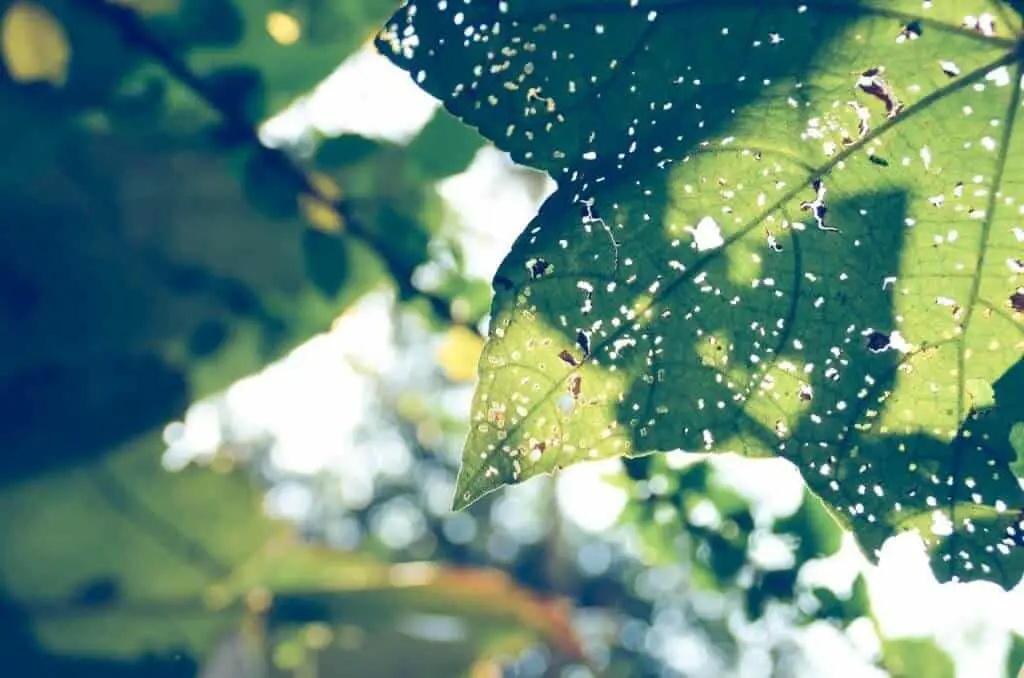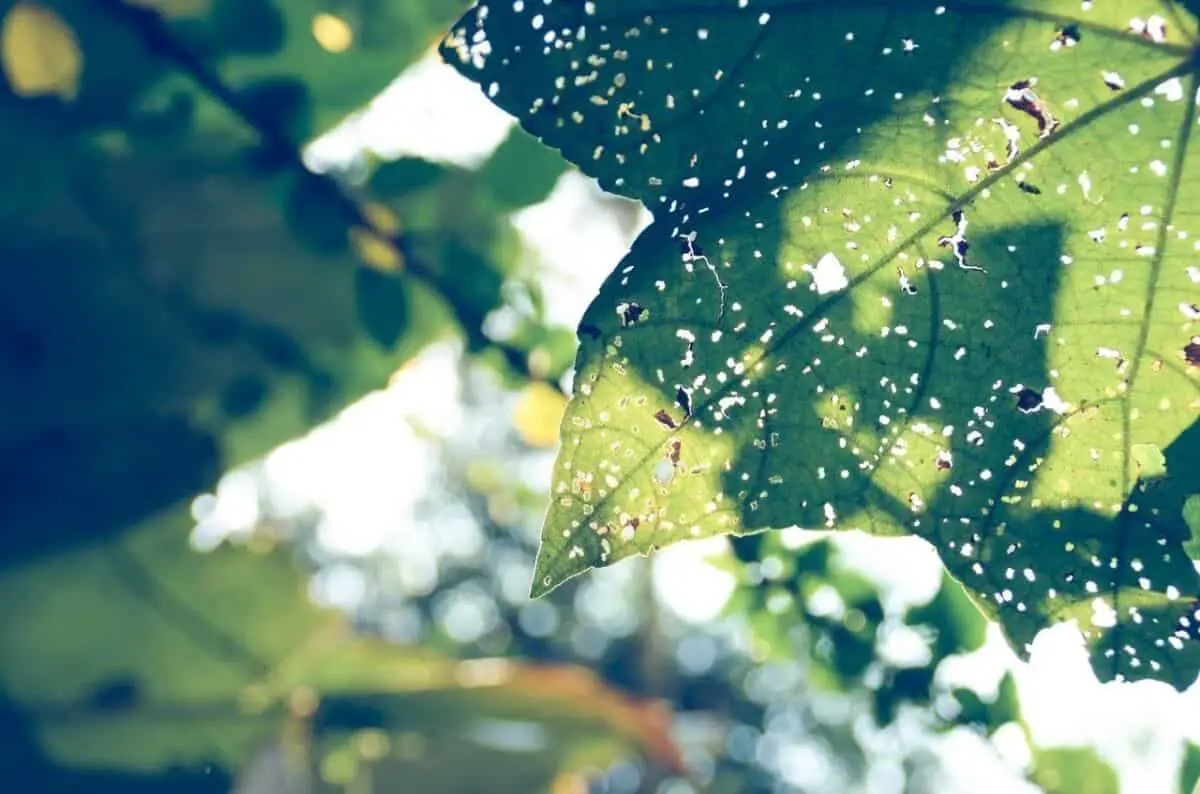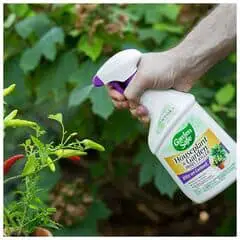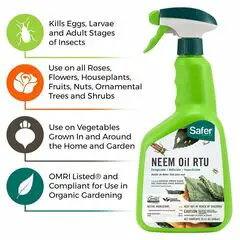If you’re a lover of the natural world and want to bring that into your humble abode, there are a few risks involved. The beauty and heightened fresh air far outweighs the hurdles it takes to develop your green thumb. But this guide will show you how to keep holes out of your plants and preventing the other pesky problems associated with indoor plants.
Why indoor plants get holes in the leaves is due to a variation of reasons, usually the causes is pests and bugs while often times it is disease in the foliage. Unfavorable conditions for the plant, like any organism, will cause it to decrease in vibrancy and potentially die. Understanding how to care for your indoor plants will help them adapt to their new indoor environment more smoothly.
Having plants around is very worth the work. This is why people garden and put in the time to have a fruitful reward of nurtured life all around them. Getting holes in your plants is a common enough issue and this guide will walk you through the possible causes to work through, as well as various remedies to heal your plant-child.
Why Indoor Plants get Holes in the Leaves:
If you’re new to this green thumb business, be patient with yourself. There is a lot to learn and hundreds of thousands of plant variations in the form of indoor plants.
I had to kill a few plants before I learned the ropes and you may too. It’s not the end of the world and now I have dozens of plants inside and outside of my home, thriving and growing as a constant reminder to me of all the beauty in the world.
Nurturing a living thing is very rewarding and with practice and persistence, the skill will develop itself as well.

When indoor plants get holes in their leaves, we usually tend to do a check all around the plant for pests and infestations of bugs that may be nibbling at your precious leaves. Examine the plant thoroughly for signs of disease or insects taking over.
Once you’ve examined the plant for these basic and most popular causes of holes in the leaves, try to look closely at the health of the plant.
When you choose a plant and are assessing the shop’s options, do remember the conditions in which it was grown in. Most plants come from a kind of greenhouse which is absolutely perfect for their growth and development.
Moving into your house, even if they are intended to be indoor plants, will be a large adaption for the plant. There will be changes in it’s direct sunlight absorption, humidity alterations, temperature conditions of your home and more factors.
This is to say – if you notice your plants are a little browner in the first couple of days, holes in the leaves or not, don’t worry. This is very normal on the initial week of transport for the plant to have a delay in adaptation. Don’t be alarmed if the color changes slightly or some leaves drop.
Once the houseplant has had a few weeks to adapt to its established interior domain, it should begin to thrive. If the problems persist and you continue to get dying plants with holes in them, you may be choosing improperly or need to switch nurseries.
You’ll want to give a true observation to the plant before you purchase it. This is very important and can make all the difference if you simply keep bringing home plants that already have holes and infestations in them. This could be the root of your problem, (pun intended).
If you keep running into this problem and are staring at your green thumb confused and hopeless, you may need to trace it back to where you’re purchasing the plants. The plant nursery may have some kind of pest issues or a common sickness/disease rampant through the breed of plant you keep purchasing.
Paying attention while you shop could fix this problem altogether, which is why I lead with it in section one. Examine the leaves for being wilted, the roots for looking chewed up, and for the obvious issue of holes or tears in the leaves. Look closely at the color health, size, and shape.
If the coloration is off or seems a bit decayed, this is your first indication that there is a nutrients problem with this plant specifically, his neighboring breeds, or the entire nursery and their method for caring for the plants.
This is not common as it’s literally the nursery’s business to understand the species of flowers and plants they care for. Most are thriving and lush, which is how they stay in business. All this to say that if you feel upset with the nursery or salesperson of plants which keep dying, it’s usually not their fault and it may be a single plant breed issue that they’re not aware of.
If you do notice an issue on the plant or a pest infiltration – let the shop owner know. It’s always kind to let the seller know what’s going on with his plants as he can’t inspect every single one of them. This way he can address the issue and know that it won’t be sold to anyone else.
It is not often the case that your dying plant is the fault of the plant breeder, as they make their living off of creating healthy plants. So be honest with yourself. If they are coming from the nursery beautiful and full of life but look dehydrated and wilted within a week of being under your care – the problem is probably you.
We will dive into each issue and the associated solutions you can try for each problem. First, we will explore the most popular issue regarding holes in your indoor plants – pests.
Pests Attacking Your Plants:
This is the main issue and reasoning for holes in your plants, so we will spend the most time and attention on this section.
If there is insect damage on your plants, there are indicators that will be visually apparent upon a close inspection. You will see actual bite marks, nibbles from tiny mouths, holes, and tears in the leaves.
If the leaves also appear misshapen or as if they’re crumbling against the predation of another living organism feeding off the plants’ nutrients – this is yet another indicator. Even if you don’t see the obvious bite marks, if the plant is small or stunted, this could mean a nutrient deficiency which also indicated pests or improper care.
After first being thoughtful in where and which plant you purchase, as we discussed in the last section, the second step will be about picking the right spot for you plant inside your home.
Choosing your plants proper placement will be detrimental to it’s growth as well. You want to be sure they have natural light pouring in over them, are watered daily (or as often as the species of plant requires) and also that there isn’t a pest problem in this part of the house.
Examples may be that you won’t want to put a lot of plants in the pet room. If your cats or dogs have fleas or other pests, that could contaminate and spread into your plant children as well as the fur children.
Be thoughtful about where you place the potted plant as this can make all the difference in their retrieval of proper nutrients. You’ll want to do your research about what kind of light this plant needs and at what intensity. Also, if the area is well-insulated and if the humidity level is aligned to the needs of this breed.
If all of these things haven’t been considered, there simply is a higher risk that your plant won’t survive anyways.
Humidity is an important factor worth considering because humidity’s moisture will attract more insects and pests to your plants. Keep in mind that there are higher humidity levels in the kitchen or bathroom, based on more moisture being moved through these spaces frequently. These may be the rooms you most want potted plants in but they’re also the most risk involved.
If you want to keep your plants in the kitchen or as a way to put more flowing oxygen through the bathroom and lower air-flow rooms that don’t get as much fresh air, this is completely understandable. Just be sure you’re considering the heightened risk for pests. We will discuss preventive measures shortly.
Different types of pests that may be attracted to your houseplants include –
- Aphids– Small greenish brown bugs, sometimes black, that can be found on the underside of leaves away from the sun. They will cause your plant growth to be stunted as they rob the nutrients from it. You will notice curled or distorted foliage.
- Mealybugs– These insects look like little cotton balls resting on the stems, undersides of the leaves, and where the leaves attach to the stem. They may just be resting on it like a tiger napping on a tree limb, but you’ll need to take action against these little fluffs. They will kill your plants and steal all of its nutrients if not treated.
- Mites – These are not exactly insects, but they are referred to as tiny light-colored arachnids. This is the same variation which spiders and scorpions fall into. If you’re picturing tiny scorpions all over your precious plants, you’ll understand why something needs to be done. Not only will they distort the nutrients and growth pattern of your plant, but you will notice webbing on the foliage that makes your plant look like an abandoned haunted house. You may also notice a yellowish tone to your plant so if you notice that first, start an in-depth search for more mite warning signs.
- Scales– These will be your standard round and brownish black bugs. They will be on the leaves and are the exact culprits for taking nibbles out of your plant. They will actually use your indoor plant like a smoothie straw and suck the juices out of it until it remains sad and lifeless. These vampires are small but absolutely deadly and need to be treated.
- Thrips– Extremely small bugs. They range from light tan to brownish, may look white when young or you may be seeing their eggs. Feed on foliage and flowers, causing them to become nutrient deficient and discolored
- Whiteflys– These tiny white bugs resemble another bothersome bug, the gnat. They will feed on the leaves allowing holes to pop up everywhere until the plant turns pale yellow or ghost white. Eerie, creepy, and not okay.
Now that you understand the major players in the indoor plant pest game, you’ll want to know how to treat this pest problem and rid your plants (and home) of them altogether!
How to Treat/Remove Pests:
To effectively treat for pests, you’ll need to know exactly which pest you’re dealing with. It’s also worth noting that if you have pets or children (or even just yourself breathing in the treatment) it’s always best to opt for a natural and non-toxic treatment.
Non-chemical treatments are always the place to start and can be as simple as a stream of water to drown the insects and remove their webbing/hold on your plants. Many botanists and plant-enthusiasts also swear by simply wiping down their plants often and keeping them dusted in the same routine in which you may dust the bookshelves.
Some swear by actually picking the pests off one by one and doing the work by hand. These are beginning steps and if you need something stronger for bugs that are almost impossible to remove like fleas, you may need to call a professional.
Often times the insects putting holes in your plants are larger pests with big mouths, like caterpillars and slugs. You can check under the leaves for them and you’ll notice a green train of fecal pellets while slugs leave a shiny residue.
Many gardeners say the easiest technique to not kill the slugs is just to pick them up and place them outside. You may also want to weed your plants and be sure there’s not small weeds in the pot which tiny critters can hide in.
If bugs continue to attack a particular flower or plant breed in your home, consider trying a new plant with less attraction to pests.
A few flowers that are known to absolutely attract bugs and should be avoided are:
- Coreopsis (Coreopsis spp.)
- Yarrow (Achillae)
- Cosmos (Cosmos Bipinnatus Cvs.)
They are too sweet and fragrant which will be an absolute magnet in your home to pests.
Another point in the process to consider is to be thought through before you even pot the plant.
Consider the soil you’re using and put it in a newly cleaned pot. Be sure you’ve used diluted soap or a small amount of bleach that is completely washed out. This will guarantee the pot is clean and ready for the healthy plant.
Soil is very important to the equation as you may be using old soil which has leftover eggs from previous pests.If you’ve had to clean the plant and purchase new, etc., yet keep having a pest problem. You may need a new brand of soil and to stop using the same pot/soil.
Sometimes there are bugs in the soil you purchase from the nursery. You may have inspected the plant, but the issue was soil-deep. You may see things like millipedes and pill-bugs which do not damage your plants. They eat dead and decaying organic material so will not take the life from your plant. If you don’t want them on your plants, simply capture them and set them outside.
Another tip for the pest issue is to place your plant away from other plants for a while.You may want to be weary that one plant could be passing disease to all of your plants. Isolate who you think is the trouble child and go from there.
Be sure leaves aren’t touching as pests will spread like wildfire when they have a convenient bridge to pass from plant to plant.
There are also plant sprays you can pick up at the nursery which will treat pests. Be sure again that they are non-toxic and won’t have the opposite effect on the clean air your new plants have brought into the house.
Some treatments to consider chemically if the water/soap and more organic tricks don’t do the trick are to use chemicals which will kills them. I opt for putting the caterpillar or slug outside to be free but if these are nasty mites or an insect you don’t feel as sympathetic for, you want them gone.
I completely understand this fury and have selected some natural chemical sprays which will do the trick. Some of the best chemical insect sprays for your home plants are:
Spectrum Houseplant & Garden Insect Spray- 24 oz bottle – Found on Amazon and is a general-purpose spray is excellent for all indoor and outdoor plants. Made with natural botanical pyrethrin’s, this will kill bugs on contact. It is worth noting that if your indoor plant is some kind of fresh vegetable/fruit, this spray can be used up until the day of harvest so it is quite non-toxic.
Safer Brand 5180-6 Neem Oil Ready-to-Use Fungicide, 1 Pack – Able to be purchased through Amazon (hello prime shipping!) this is around $15 and created to Kill eggs, larvae and adult Stages of Insects. This formula will also prevent & kills black spots, powdery mildew, and more. Well rated and can be used on vegetables, flowers, leaves, etc.
Natural Indoor Pest Control for Home and Kitchen– Perhaps the most natural formula of all the options on this spray list, it is also the highest price point. Around $35 a bottle on Amazon, this 5-star formula is top-rated to fix your indoor insect infestation while not being harmful to your beloved plant or toxic to the air you and your family breathe. A great option if you’ve exhausted many other options and are ready to invest in something a little nicer.
For more products, check out our recommended product page.
Disease in House Plants:
Disease in your house plants is another common issue and reason for premature deaths. It may not cause holes in your leaves, but you’ll have plenty of other problems if your plants keep getting sick.
Most houseplants will experience few diseases however some are weakened during the state of moving from greenhouse environments to inside a home. This time will essentially break down their immune system and force them to rebuild while adapting to their new home inside air conditioning and away from natural sunlight/rainfall.
Funny enough, using the wrong pest treatments for holes on your leaves can result in an ill or diseased plant. This is usually the result of using harsh chemicals which poison the plant or harsh bleach.
Some common houseplant diseases, their symptoms to watch out for, and each diseases’ remedy are as follows:
- Leaf spots– this is caused by fungal issues and bacterial overgrowth on your plants.
How to Fix:Remove infected leaves, increase air circulation, and avoid getting water on leaves. This will create a high moisture environment that is too much of a breeding ground for bacteria on their already weakened leaves. Keep the water in the soil and keep an eye on it.
- Powdery mildew– This can be mistaken for the white cotton ball pests but will be powderier and more widespread on the foliage. This is a fungal overgrowth which will result in leaves falling or being distorted.
How to Fix:To reduce powdered mildew you’ll need to increase the air circulation and put it in a room with lower humidity. Remember that the kitchen and bathroom are the highest points of humidity in the home so perhaps removing them from these spaces will do the trick. Avoid saturated soils and always remove leaves that look deeply infected to avoid the spread of it to other leaves/neighboring plants.
- Root and stem rots– you will notice brown to black soft roots; There may be a soft line in the soil or you’ll see your plant actually rotting away, wilting, until it eventually dies. Keep an eye out for darkened root and stem on your indoor plants.
How to Fix:Don’t overwater your plants and always remove the infected leaves so it doesn’t spread. Cut the infected root and repot in a sterile pot/clean mix without bugs if necessary.
Plants that Repel Pests and Insects:
For this last section, since the focus is on holes being in your leaves and holes being due to pests – I wanted to add in a section of different plant and herb options that actually repel insects!
These options are proof that mother nature has always had her secret methods to deter pests. It’s not a fight in nature against the two of them, but in reality the plants exude a fragrance that is plain nasty to bugs.
Good news for us, planting these breeds near our other houseplants could be the perfect solution for getting rid of pests and removing those holes from our indoor vegetation altogether.
The best plant options for inside the home which will deter and repel pests are:
- Basil – great to keep in the kitchen and grab for meals, it will also combat the issues other plants are having in this high-humidity space. Insects hate basil but they’re great in your salad or pasta! Also, very easy to grow, it will eliminate other pests such as house flies and mosquitoes.
- Lemongrass– The helpful component here is the citronella which makes lemongrass the king of insect repellent. Pleasant enough in smell it will add a fresh citrus essence to your home. Avoid the citronella candles as they are filled with toxins. Instead, plant some lemongrass! Best placed near the doors and windows where they tend to sneak in and attack our precious house plants.
- Lavender – With its lovely scent and proven nature to relax us, this miracle plant will help you sleep, calm your home’s energy, as well as repel bugs! The scent we love so much is disgusting to bugs and you can see many natural bug sprays made with lavender and lemongrass for this very reason. Some believe in placing fresh lavender in their drawers and closets as well to deter moths, fleas, and even rodents.
With these floral weapons in your artillery belt – Bugs will have to think twice about crossing your homes. These added boundaries will offer your other plant breeds a second wall of protection to thrive in.
Final Thoughts:
Plants are growing organisms that are predisposed to thrive. Don’t worry too much about holes in the leaves unless your plants continuously die because of it. Plants originate in nature where they’re covered in pests and bugs all the time. They are adapted to this and a slug here and there that you have to place outside is not the end of the world.
For the most part, a healthy plant will be based on where you place it inside the home, proper sunlight, clean soil, and regular waterings at the degree in which that brand needs to be watered (some require only a couple times a month or less with dry-environment breeds like cactus).
Inspect your plant regularly that they’re free of pests and you’ve done the hard part! Now taking care of them should be a smoother path and you can avoid having to purchase all of those replacement house plants.
Don’t be too judgmental if your plant has a few holes here and there. It’s not detrimental and would be much worse in the real conditions of outdoor nature. Plants thrive despite this and will continue to grow as long as they have proper love and care.
Give your plants some TLC and you’ll see a huge difference in their quality of life, the lightness and fresh air in your home, as well as your overall green thumb abilities!
Your plants are real and not artificial, so they are bound to have a few imperfections. Funny how in that way, flawed beauty is just like the beauty of imperfect people.
I’d rather have the real, raw, and imperfect over artificial any day. How about you?






Subscribe To Our Newsletter
Join our mailing list to receive news and updates. Don't worry. We will not smap you ;)
You have Successfully Subscribed!